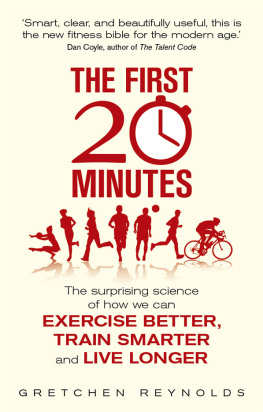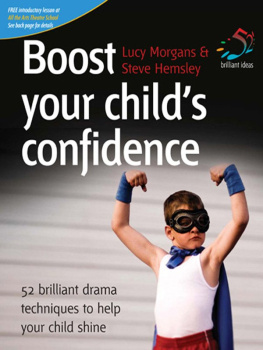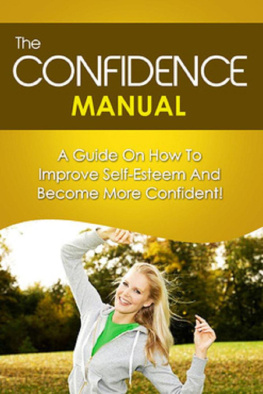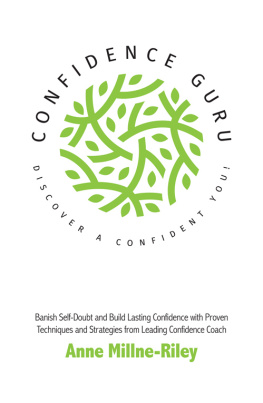Reynolds - Confidence Training: Practical Step-by-Step Guide for Gaining Confidence in Work and Life
Here you can read online Reynolds - Confidence Training: Practical Step-by-Step Guide for Gaining Confidence in Work and Life full text of the book (entire story) in english for free. Download pdf and epub, get meaning, cover and reviews about this ebook. year: 2015, genre: Religion. Description of the work, (preface) as well as reviews are available. Best literature library LitArk.com created for fans of good reading and offers a wide selection of genres:
Romance novel
Science fiction
Adventure
Detective
Science
History
Home and family
Prose
Art
Politics
Computer
Non-fiction
Religion
Business
Children
Humor
Choose a favorite category and find really read worthwhile books. Enjoy immersion in the world of imagination, feel the emotions of the characters or learn something new for yourself, make an fascinating discovery.
Confidence Training: Practical Step-by-Step Guide for Gaining Confidence in Work and Life: summary, description and annotation
We offer to read an annotation, description, summary or preface (depends on what the author of the book "Confidence Training: Practical Step-by-Step Guide for Gaining Confidence in Work and Life" wrote himself). If you haven't found the necessary information about the book — write in the comments, we will try to find it.
Confidence Training: Practical Step-by-Step Guide for Gaining Confidence in Work and Life — read online for free the complete book (whole text) full work
Below is the text of the book, divided by pages. System saving the place of the last page read, allows you to conveniently read the book "Confidence Training: Practical Step-by-Step Guide for Gaining Confidence in Work and Life" online for free, without having to search again every time where you left off. Put a bookmark, and you can go to the page where you finished reading at any time.
Font size:
Interval:
Bookmark:

ConfidenceTraining
Practical Step-by-Step Guide for Gaining Confidence in Work and Life
HUGOREYNOLDS
Text Copyright Author
All rights reserved. No part of this guide may bereproduced in any form without permission in writing from the publisher exceptin the case of brief quotations embodied in critical articles or reviews.
Legal & Disclaimer
Legal & Disclaimer
Theinformation contained in this book is not designed to replace or take the placeof any form of medicine or professional medical advice. The information in thisbook has been provided for educational and entertainment purposes only.
Theinformation contained in this book has been compiled from sources deemedreliable, and it is accurate to the best of the Author's knowledge; however,the Author cannot guarantee its accuracy and validity and cannot be held liablefor any errors or omissions. Changes are periodically made to this book. Youmust consult your doctor or get professional medical advice before using any ofthe suggested remedies, techniques, or information in this book.
Upon usingthe information contained in this book, you agree to hold harmless the Authorfrom and against any damages, costs, and expenses, including any legal feespotentially resulting from the application of any of the information providedby this guide. This disclaimer applies to any damages or injury caused by theuse and application, whether directly or indirectly, of any advice orinformation presented, whether for breach of contract, tort, negligence,personal injury, criminal intent, or under any other cause of action.
You agreeto accept all risks of using the information presented inside this book. Youneed to consult a professional medical practitioner in order to ensure you areboth able and healthy enough to participate in this program.
Table of Contents
Whatis self-confidence?
Whydo we lack self-confidence?
Self-Inventoryof confidence
1) Listing
2) Understandingthe origin
3) Writedown what kind of confidence you want to
4) Makea simple action plan
5) Setsmall and measurable goals
1) Getthe information you need
2) Staypositive and optimistic
3) Createa support network
4) Remindyourself of your strengths
5) Takeinformed risks
1) 4tough situations
2) Howto handle them
1) TakingCare of Yourself
2) Realizethe importance of self-care
3) Practicegood hygiene
4) Takecare of your health
5) Manageyour sleep schedule
1) Becomeaware. Know who you are and what you want.
2) MotivateYourself
3) TakeCare of Yourself
4) DevelopYour Mind
5) Stayon Top of Things and Reinforce
1) Takeaction. Get it done.
2) FaceYour Fear
3) Understandin what order things happen
4) Prepare
5) Realizethat failure or being wrong will not kill you
6) Getto know who you are and what you want out of life
1) Helppeople learn and develop.
2) DelegateTrust
3) Focuson peoples strengths
4) Besupportive
5) Embracefailure
- Whatthis guide has taught you
- Howcan you apply what youve learned right away

INTRODUCTION
______________________________________________________________________________
Humanbeings come into this life dressed in the same cover of skin. Some peoplechoose different paths, and others lurk in the shadows of their ancestors. Eachand every one grows up with certain motives which form the idea of futureprospects. Some develop their motives early in childhood, and some others donot; or even forsake their past dreams of the lost future. The flame that burnsin every human being, which makes him able to pursue the end of the lines hedrew for himself, at times seem to wither. The reason behind such obstaclemight be lack of interest over time, fear of failure or the root of it all:self-confidence.
Well,self-confidence might not be the sole reason behind such inexplicable regress;rather the lack of it. As human beings, we all have the ability to acquireself-confidence through various ways. However, we are also capable of drainingour storage of it. The way most people perceive self-confidence is somewhatblurred. People tend to define it as merely a human trait; a gift for whom maybe blessed. Yet, that idea could not be more wrong. The repercussions of suchmisconception can simply be defined as fatal. When one regards self-confidenceas a gift, it gets associated with luck or legacy; as if it cannot be acquired.And when the latter option is not present in one's thinking, it could lead to ableak perspective on personality and on life in general. If self-confidence wasmerely a trait that passes down through genes, then just few families wouldhave been running the whole world. One needs to regard self-confidence as amental muscle. The human being needs to physically let the muscles tire throughexercises in order to develop and grow. This is the exact process that themuscle of self-confidence needs for it to be acquired and everlastinglyattained. People think that self-confidence comes once in a lifetime and shouldimprove it hitherto. However, what most people seem to miss is that confidenceis a loose quality; it comes and it definitely goes. It all depends on theperson in charge and the functionality of their psychological code.
Thequality of self-confidence needs to be petted and looked after. Like theprocess of planting a tree. At first, you throw the seed deep down in the soil.It may not seem very beneficial or a necessary creation; yet, with dailywatering and care, it would sprout its way out of the dirt and embrace thescorching sunrays of the day. For the tree to develop its thick roots, itsrustling leaves and its blooming fruits, one must attend to its needs first. Inthis book, we're going to discuss the meaning of true self-confidence, andthrough which way should the reader acquire it. But first of all, the readermust understand that such psychological processes cannot be made easier with anexternal source of help; it may be smoothened, but hard effort is still anessential part of the whole system. We are going to inspect the cases in whichhuman beings seem to yield for desperation, and lose their sense of achievementand self-confidence. Some people face dreading insecurities posed upon them bysociety and the media; others fall for denial or inner doubts and fear offailure.
Allthese various aspects can be associated with the lack of self-confidence. Thelack in one of the earlier traits can lead to regression in the self-inventoryof confidence, and vice versa. The reader must acknowledge his crucial part inthis learning process. The information cannot be simply passed down from theauthor to the audience, and in any way expect magical results. Our words shouldbe pondered upon and coherently contemplated through deep thinking and constantself-evaluation. The trait of self-confidence is a common trait in all human beings;although it might not be apparent at first, but it can be drawn to unveilitself to the world. The real problem is that one might be too indulged in self-doubtto the point that he doubts his capability of finding self-confidence withinhimself.
Step1, Setting Goals

Thefirst thing you need to think about is your own personal prospects. Suchprospects are the goals that determine your perspectives of the future. Youneed to locate your motives and the true desires that keep you going throughlife; in that respect, you may define your essence and identity which isessential in the journey of acquiring self-confidence. One must find thepersonal and psychological passage through which all the hidden aspects ofhuman nature may unfurl. Stepping through such vague, yet vast tunnel, cangrant the doer great rewards.
Font size:
Interval:
Bookmark:
Similar books «Confidence Training: Practical Step-by-Step Guide for Gaining Confidence in Work and Life»
Look at similar books to Confidence Training: Practical Step-by-Step Guide for Gaining Confidence in Work and Life. We have selected literature similar in name and meaning in the hope of providing readers with more options to find new, interesting, not yet read works.
Discussion, reviews of the book Confidence Training: Practical Step-by-Step Guide for Gaining Confidence in Work and Life and just readers' own opinions. Leave your comments, write what you think about the work, its meaning or the main characters. Specify what exactly you liked and what you didn't like, and why you think so.
















